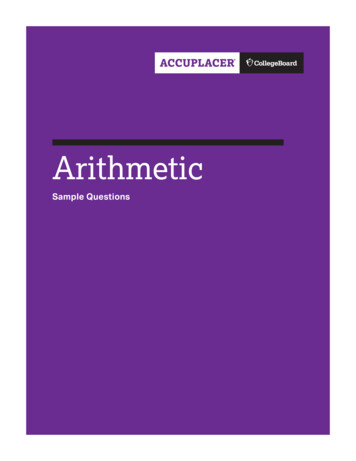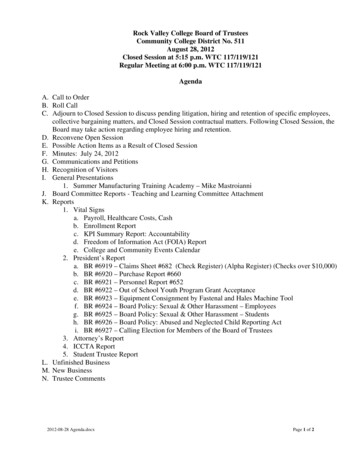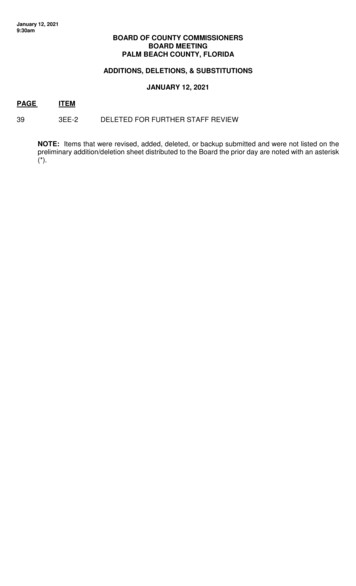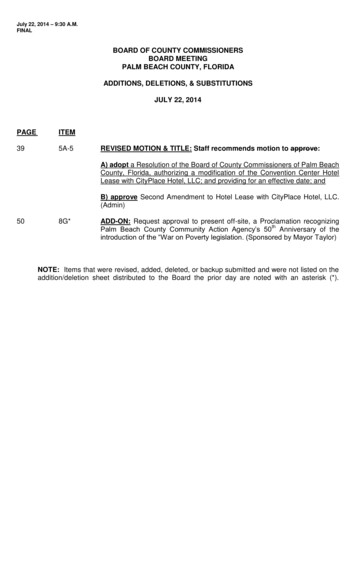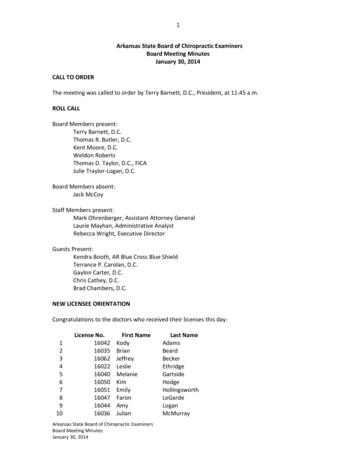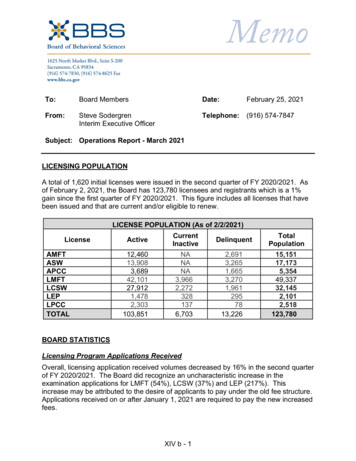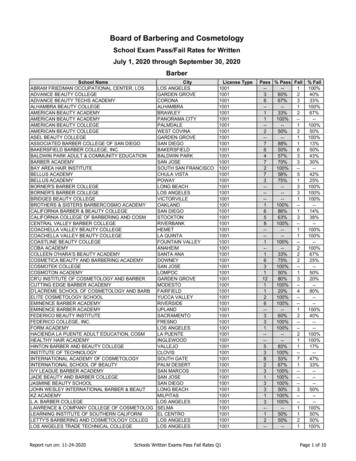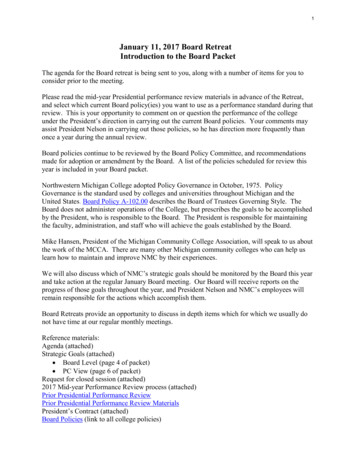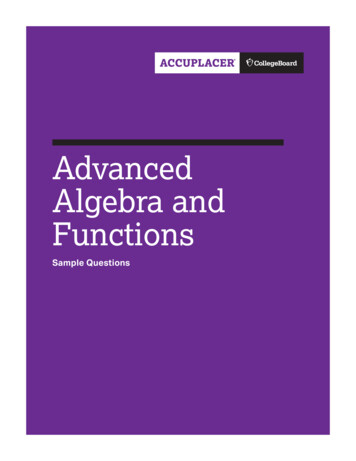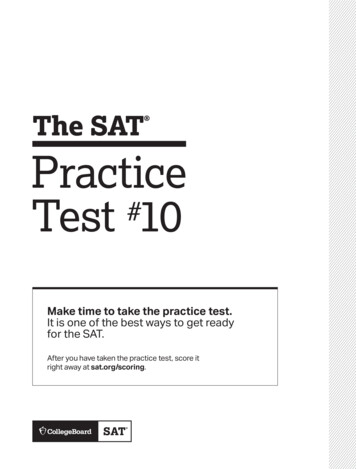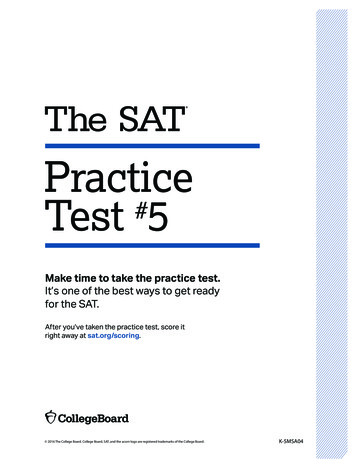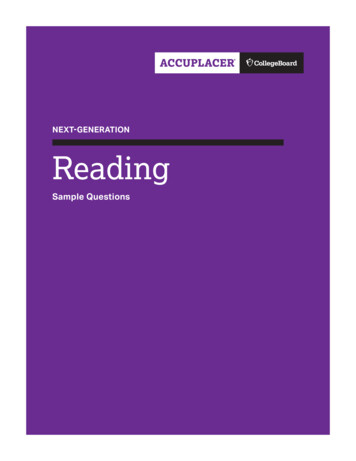
Transcription
NEXT-GENERATIONReadingSample Questions
The College BoardThe College Board is a mission-driven not-for-profit organization that connects studentsto college success and opportunity. Founded in 1900, the College Board was created toexpand access to higher education. Today, the membership association is made up ofover 6,000 of the world’s leading education institutions and is dedicated to promotingexcellence and equity in education. Each year, the College Board helps more than sevenmillion students prepare for a successful transition to college through programs andservices in college readiness and college success—including the SAT and the AdvancedPlacement Program . The organization also serves the education community throughresearch and advocacy on behalf of students, educators, and schools.For further information, visit collegeboard.org.ACCUPLACER Reading Sample QuestionsThe Next-Generation Reading test is a broad-spectrum computer adaptive assessmentof test-takers’ developed ability to derive meaning from a range of prose texts and todetermine the meaning of words and phrases in short and extended contexts. Passageson the test cover a range of content areas (including literature and literary nonfiction,careers/history/social studies, humanities, and science), writing modes (informative/explanatory, argument, and narrative), and complexities (relatively easy to verychallenging). Both single and paired passages are included. The test pool includes bothauthentic texts (previously published passages excerpted or minimally adapted fromtheir published form) and commissioned texts (written specifically for the test). Questionsare multiple choice in format and appear as both discrete (stand-alone) questions andas parts of sets of questions built around a common passage or passages. Four broadknowledge and skill categories are assessed: Information and Ideas (reading closely, determining central ideas and themes,summarizing, understanding relationships) Rhetoric (analyzing word choice rhetorically, analyzing text structure, analyzing pointof view, analyzing purpose, analyzing arguments) Synthesis (analyzing multiple texts) Vocabulary 2017 The College Board. College Board, ACCUPLACER, and the acorn logo are registeredtrademarks of the College Board.00716-019ACCUPLACERNext-Generation Reading 2017 The College Board.1
Sample Questions(11) And now tonight, with twenty-four hours togo, they had somehow managed to bring it of.(12) Giddy in the unfamiliar feel of make-up andcostumes on this frst warm evening of the year, theyhad forgotten to be afraid: they had let the movementof the play come and carry them and break like awave; and maybe it sounded corny (and what if itdid?) but they had all put their hearts into their work.(13) Could anyone ever ask for more than that?Directions for questions 1-18Read the passage(s) below and answer the questionbased on what is stated or implied in the passage(s) andin any introductory material that may be provided.In this passage, an amateur theater group called theLaurel Players is putting on its frst production.(1) Te Players, coming out of their various kitchendoors and hesitating for a minute to button theircoats or pull on their gloves, would see a landscapein which only a few very old, weathered housesseemed to belong; it made their own homes look asweightless and impermanent, as foolishly misplacedas a great many bright new toys that had beenlef outdoors overnight and rained on. (2) Teirautomobiles didn’t look right either—unnecessarilywide and gleaming in the colors of candy and icecream, seeming to wince at each splatter of mud,they crawled apologetically down the broken roadsthat led from all directions to the deep, level slabof Route Twelve. (3) Once there the cars seemedable to relax in an environment all their own, along bright valley of colored plastic and plate glassand stainless steel—KING KONE, MOBILGAS,SHOPORAMA, EAT—but eventually they had toturn of, one by one, and make their way up thewinding country road that led to the central highschool; they had to pull up and stop in the quietparking lot outside the high-school auditorium.From Richard Yates, Revolutionary Road. 1989 by RichardYates. Originally published in 1961.1.Te contrasts the narrator draws in sentences 1 and 2between the Players’ homes and the houses in the“landscape” and between the Players’ automobiles andthe “roads” are most likely meant to suggest that thePlayers’ homes and automobiles areA. old and neglectedB. modern and alienC. small but expensiveD. grand but unappreciated2.Based on the passage, which of the following mostaccurately characterizes the claim that “there was plentyof time to smooth the thing out” (sentence 8)?A. A comforting falsehood that the Players know to beuntrueB. An outright lie that the director persuades thePlayers to acceptC. An optimistic conclusion reached by outsideobservers watching an early rehearsalD. A realistic appraisal ofered by the director afercareful analysis of the play’s shortcomings3.Te descriptive language in sentence 10 is mainly intendedto reinforce the passage’s depiction of the Players’A. growing resentment of the director’s leadershipB. increasing reluctance to work as hard as they havebeenC. lingering doubts about their fellow cast membersD. persistent mood of despair regarding the play4.Te narrator most strongly suggests that which of thefollowing resulted in the transformation described inthe last paragraph?A. Te change in time of day during which rehearsalswere being heldB. Te greater frequency with which rehearsals werebeing scheduledC. Te shif in the director’s style from strict to moreforgivingD. Te break in routine occurring the day before thefrst performance(4) “Hi!” the Players would shyly call to oneanother.(5) “Hi! . . .” (6) “Hi! . . .” (7) And they’d goreluctantly inside.(8) Clumping their heavy galoshes around thestage, blotting at their noses with Kleenex andfrowning at the unsteady print of their scripts,they would disarm each other at last with peals offorgiving laughter, and they would agree, over andover, that there was plenty of time to smooth thething out. (9) But there wasn’t plenty of time, andthey all knew it, and a doubling and redoublingof their rehearsal schedule seemed only to makematters worse. (10) Long afer the time had comefor what the director called “really getting thisthing of the ground; really making it happen,”it remained a static, shapeless, inhumanly heavyweight; time and time again they read the promiseof failure in each other’s eyes, in the apologeticnods and smiles of their parting and the spastichaste with which they broke for their cars anddrove home to whatever older, less explicitpromises of failure might lie in wait for them there.ACCUPLACERNext-Generation Reading 2017 The College Board.2
Passage 1Green Bank, West Virginia, is a tech-savvy teenager’snightmare. In this tiny town in Pocahontas County—population 143—wireless signals are illegal. Nocell phones. No WiFi. No radio. No Bluetooth. Noelectronic transmitters at all. You’re not even allowedto cozy up to an electric blanket.5.Te main purpose of the last paragraph of Passage 1 isto oferA. criticismB. justifcationC. exemplifcationD. comparison6.Which conclusion can reasonably be drawn about thestatus of the “lawnbot” issue at the time of the writing ofPassage 2?A. Te manufacturer has received a waiver to operatewithin the National Radio Quiet Zone.B. Te manufacturer has changed the wavelength atwhich the lawnbot’s beacons transmit.C. Astronomers have succeeded in getting GPS devicesadded to each lawnbot.D. Te manufacturer and astronomers have yet toresolve their confict.7.Which choice best describes the relationship betweenthe two passages?A. Passage 1 mainly discusses the National RadioQuiet Zone in general, while Passage 2 mainlydiscusses a particular threat to the zone’s integrity.B. Passage 1 focuses on Green Bank, West Virginia,while Passage 2 focuses on the National RadioQuiet Zone surrounding the town.C. Passage 1 evaluates drawbacks of the NationalRadio Quiet Zone, while Passage 2 evaluatesbenefts of the zone.D. Passage 1 ofers praise for astronomers, whilePassage 2 ofers criticism of astronomers.8.Given the evidence in the passages, with whichstatement would the authors of both passages mostlikely agree?A. Radio telescopes could be used to measure snowfallamounts.B. Te Green Bank Telescope can detect extremelysmall amounts of energy.C. Increased sales of robotic lawn mowers may requirethe creation of more radio quiet zones.D. Te lack of modern technology has made peoplemove away from Pocahontas County.Te remote town is smack in the center of theNational Radio Quiet Zone, a 13,000 squaremile stretch of land designated by the FederalCommunications Commission to protect twogovernment radio telescopes from human-madeinterference. Te rules are most strict in GreenBank. So strict that a police ofcer roves the streetslistening for forbidden wireless signals.It’s necessary, though. Te town is home to theGreen Bank Telescope, the largest steerable radiotelescope in the world—and arguably our mostpowerful link to the cosmos. Scientists there listento radio energy that has journeyed light years,unlocking secrets about how the stars and galaxiesformed. A rogue radio signal could preventpotential discoveries, discoveries that could answerbig questions about how the universe ticks.Adapted from Lucas Reilly, “Te West Virginia Town WhereWireless Signals Are Illegal.” 2013 by Mental Floss, Inc.Passage 2Lawn mowers seem to have little in common withastronomy, but they are keeping astronomers atthe National Radio Astronomical Observatory upat night. A new type of robotic lawn mower hasbeen proposed that uses beacons to train the lawnmower to stay within property lines. Te beacons,placed around the yard, transmit at the samewavelength as interstellar molecules astronomersstudy to understand how stars form. Humanswouldn’t notice the tiny amount of energy given ofby the beacons, but the Green Bank Telescope—thesize of a football stadium—is so sensitive it candetect the energy given of by a snowfake as itmelts. By simply mowing the lawn, a homeownerruns the risk of interfering with one of our greatesttools for studying the universe.Te manufacturer of one “lawnbot” requested awaiver to operate within the National Radio QuietZone. Astronomers countered with the suggestionthat the beacons be reprogrammed to transmitat another wavelength not emitted by interstellarmolecules. Alternately, astronomers want globalpositioning system (GPS) devices added to eachlawnbot to prevent them from operating within theQuiet Zone.ACCUPLACERNext-Generation Reading 2017 The College Board.3
As soon as I saw the Manhattan map, I wanted todraw it. I should be able to draw the place whereI lived. So I asked Mom for tracing paper and shegot it for me and I brought it into my fort and Ipointed the light right down on the frst map in theHagstrom Atlas—downtown, where Wall Streetwas and the stock market worked. Te streets werecrazy down there; they didn’t have any kind ofstreets and avenues; they just had names and theylooked like a game of Pick-Up Sticks. But before Icould even worry about the streets, I had to get theland right. Manhattan was actually built on land.Sometimes when they were digging up the streetsyou saw it down there—real dirt! And the land hada certain curve to it at the bottom of the island, likea dinosaur head, bumpy on the right and straight onthe lef, a swooping majestic bottom.From Ned Vizzini, It’s Kind of a Funny Story. 2006 by Ned Vizzini.9.In the passage, the use of “crazy,” “dinosaur head,”“bumpy,” “straight,” and “swooping” serve mainly toemphasize theA. narrator’s serious approach to mapmakingB. narrator’s frustration with drawingC. irregularity of downtown ManhattanD. ways in which a landscape can change over timeTe life of Edith Wharton is not an inspiriting ragsto-riches saga, nor is it a cautionary tale of riches torags—riches to riches, rather. Born Edith NewboldJones, in January of 1862, into one of the leadingfamilies of New York, the author maintainedmultiple establishments and travelled in the higheststyle, with a host of servants, augmenting herseveral inheritances by writing best-selling fction.In the Depression year of 1936, when two thousanddollars was a good annual income, her writingearned her a hundred and thirty thousand, muchof it from plays adapted from her works. Yet herwell-padded, auspiciously sponsored life was notan easy one. Te aristocratic social set into whichshe was born expected its women to be ornamental,well-sheltered, intellectually idle agents of theirinterwoven clans, whereas Edith was an awkward,red-haired bookworm and dreamer, teased by hertwo older brothers about her big hands and feet andout of sympathy with her intensely conventionalmother, née Lucretia Stevens Rhinelander—amother-daughter disharmony that rankled inEdith’s fction to the end.10. Which choice best describes the overall structure of thepassage?A. Biographical incidents are recountedchronologically.B. An author’s life is connected to various themes inher work.C. Te works of two authors are compared andcontrasted.D. A list of advantages is followed by a list ofdisadvantages.Bones found in South America reveal a bizarrenew dinosaur. Based on an ancestry that links it toTyrannosaurus rex, this reptile should have been ameat eater. Instead, it preferred plants. Researchersdescribed the new species in Nature.Its genus name—Chilesaurus—refects that itwas found in what’s now Chile. Te team thatdiscovered the fossils gave it a species name ofdiegosuarezi to honor Diego Suarez. While just 7years old, Diego found the frst dinosaur bones inthe same general area of Chile. It’s a place knownas the Toqui Formation.C. diegosuarezi roamed South America 150 millionyears ago. It measured about 3 meters (roughly10 feet) from head to tail. Its sturdy back legs,thin body and short, stout arms made it look a bitlike T. rex. But it also had a long neck, small headand a mouth full of leaf-shaped teeth. Tose gaveit a Brontosaurus-like appearance. And like theBrontosaurus, it would have eaten plants, making itan herbivore.Adapted from Ashley Yeager, “‘Frankenstein’ DinoShowed a Mashup of Traits.” 2015 bySociety for Science & the Public.11. When the author writes that C. diegosuarezi “shouldhave been a meat eater,” she most likely means that thespeciesA. would have been healthier if it had eaten meatB. would have grown even larger if it had eaten meatC. had the head, neck, and teeth of a meat eaterD. had body features similar to those of its meat-eatingrelativeAdapted from John Updike, “Te Changeling,” a review ofthe biography Edith Wharton by Hermione Lee. 2007 by Condé Nast.ACCUPLACERNext-Generation Reading 2017 The College Board.4
Te frst album that singer Leehom Wang boughtas an adolescent was the Beastie Boys’ Licensedto Ill; his frst concert was Heart, at the WarMemorial in Rochester, New York. As for Chinesepop music, though, Wang says he recalls hearing itonly once as a youngster—when his singer uncle,Li Jian-fu, paid a visit in the 1980s and played hisnationalistic-patriotic hit “Descendants of theDragon” in Wang’s living room.Wang didn’t know it then, but he would go onto remix “Descendants of the Dragon” for a newgeneration, adding new lyrics about his parents’own immigrant experience. Over the last decade,Wang’s songs have frequently emphasized hisdedication to and pride in his Chinese heritage—themes that refect his personal journey and havea powerful commercial appeal, particularly on themainland.At the same time, Wang has demonstrated a stronginterest in incorporating traditional Chinese musicand instruments into his hip-hop and R&B-basedtunes.Adapted from Julie Makinen, “Can Leehom WangTranscend China and America’s Pop Cultures?” 2014 by Los Angeles Times.12. Te second paragraph marks a shif in the passage froma discussion of Leehom Wang’sA. family members to Leehom Wang himselfB. early musical infuences to his later musical careerC. interest in the United States to his interest in ChinaD. fondness for pop music to his fondness fortraditional musicTechnology has scrambled the lines betweenpublic and private. Cellphones make our mostintimate conversations available to anyone withinearshot, while headphones create zones of puresolitude even in the midst of the liveliest crowd.Smartphones and tablets allow us to spend timewith art without ever leaving the ofce, whilesophisticated new robots enable people who arehouse-bound to participate in live events remotely.13. Which of the following would be most similar to theexamples the author provides in the passage?A. A person’s confdential information iscompromised because that person lef some papersin a public place.B. A person enjoys numerous television programs, sothat person buys a sophisticated new television onwhich to watch them.C. A person’s unfltered frst reaction to a major eventbecomes widely known because that person posts itonline.D. A person wants to keep a record of his or herprivate thoughts, so that person secretly startskeeping a daily journal.Construction management is ideal for someone whohas a general interest in building and design. Workingas a construction manager afords the chance to learna construction project from the planning stage witharchitects and engineers, to the budgeting stage withcost estimators, to the production stage with laborers.And that’s just a small taste of the job’s duties:Construction managers also obtain work permits,hire contractors, troubleshoot emergencies, schedulewalkthroughs and keep clients informed on worktimetables and progress.Adapted from “Best Construction Jobs: ConstructionManager.” 2015 by U.S. News & World Report LP.14. Te passage most strongly emphasizes which aspect ofthe job of construction management?A. Te variety of its responsibilitiesB. Te educational background it requiresC. Te kind of person for whom it is suitableD. Te amount of stress it infictsAdapted from Philip Kennicott, “How to Act in Public Spacesin a Digital Age.” 2015 by the Washington Post.ACCUPLACERNext-Generation Reading 2017 The College Board.5
In this passage, “serialization” refers to thepublication of installments, or parts, of an ongoingstory in a newspaper or magazine.Te Pickwick Papers (1836-7) wasn’t the originalserialized novel—the format had existed for atleast a century prior—but it was the work thattruly popularized the form. Te frst installmenthad a print order of 1,000 copies; by the timethe fnal entry was published, circulationhad reached 40,000. Buoyed by the success ofPickwick, Charles Dickens serialized his workfor the rest of his career, and scores of othernotable Victorian novelists joined the publishingcraze. William Makepeace Tackeray’s VanityFair, Wilkie Collins’s Te Woman in White andArthur Conan Doyle’s Sherlock Holmes stories allemerged as serials. Old and new magazines, suchas Blackwood’s and Household Words, competedfor established and emerging voices. Te constantinfux of unresolved plots and elliptical sectionbreaks stoked a fervor for fction in VictorianEngland. It wasn’t until book production becamecheap and easy, and new mediums such as radioarose to fll leisure time, that serialization slowlyshriveled away.Adapted from Hillary Kelly, “Bring Back the Serialized Novel.” 2015 by the Washington Post.15. Which of the following does the author ofer as evidenceto support the point that, for a time, serialization washighly successful?A. Te change in circulation for Te Pickwick PapersB. Te use of unresolved plots and elliptical sectionbreaksC. Te decrease in cost of book productionD. Te development of new mediums, such as radioTe neighborhood of Harlem in the twentiesofered up a cultural richness that made everythingseem possible. Jervis Anderson, writing in theNew Yorker in 1981, noted, “Harlem has neverbeen more high-spirited and engaging
Green Bank, West Virginia, is a tech-savvy teenager’s nightmare. In this tiny town in Pocahontas County— population 143—wireless signals are illegal. No cell phones. No WiFi. No radio. No Bluetooth. No electronic transmitters at all. You’re not even allowed Te remote town is smack in
